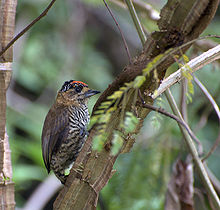Piculet
| Piculets | |
|---|---|

| |
| Ochre-collared piculet | |
| Scientific classification | |
| Domain: | Eukaryota |
| Kingdom: | Animalia |
| Phylum: | Chordata |
| Class: | Aves |
| Order: | Piciformes |
| Family: | Picidae |
| Subfamily: | Picumninae |
| Genera | |
The piculets are a distinctive subfamily, Picumninae, of small woodpeckers which occur mainly in tropical South America, with just three Asian and one African species.
Like the true woodpeckers, piculets have large heads, long tongues which they use to extract their
Their bills are shorter and less dagger-like than the true woodpeckers, so they look for insects and grubs mainly in decaying wood. Similarly, they re-use woodpecker holes for nesting, rather than making their own holes. The eggs are white, as with many hole nesters.
Typically these birds have grey or dull green upperparts and dark-streaked white underparts.
Systematics and evolution
Although not well known from
The Antillean piculet (Nesoctites micromegas) has proven to be a very distinct species evolutionarily between piculets and woodpeckers[2] and thus is nowadays placed in a subfamily of its own.[3]
The arrangement of species in the genera is as follows[4]
Genus Picumnus
- Speckled piculet, P. innominatus
- Bar-breasted piculet, P. aurifrons
- Orinoco piculet, P. pumilus
- Lafresnaye's piculet, P. lafresnayi
- Golden-spangled piculet, P. exilis
- Black-dotted piculet, P. nigropunctatus
- Ecuadorian piculet, P. sclateri
- Scaled piculet, P. squamulatus
- White-bellied piculet, P. spilogaster
- Arrowhead piculet, P. minutissimus
- Spotted piculet, P. pygmaeus
- Speckle-chested piculet, P. steindachneri
- Varzea piculet, P. varzeae
- White-barred piculet, P. cirratus
- Ocellated piculet, P. dorbignyanus
- Ochre-collared piculet, P. temminckii
- White-wedged piculet, P. albosquamatus
- Rusty-necked piculet, P. fuscus
- Rufous-breasted piculet, P. rufiventris
- Ochraceous piculet, P. limae
- Mottled piculet, P. nebulosus
- Plain-breasted piculet, P. castelnau
- Fine-barred piculet, P. subtilis
- Olivaceous piculet, P. olivaceus
- Greyish piculet, P. granadensis
- Chestnut piculet, P. cinnamomeus
Genus Sasia
- Rufous piculet, S. abnormis
- White-browed piculet, S. ochracea
Genus
- African piculet, V. africana
References
- Benz, Brett W.; Robbins, Mark B. & Peterson, A. Townsend (2006) Evolutionary history of woodpeckers and allies (Aves: Picidae): Placing key taxa on the phylogenetic tree. Molecular Phylogenetics and Evolution 40: 389–399. PMID 16635580(HTML abstract)
- del Hoyo, J.; Elliott, A. & Sargatal, J. (editors) (2002): ISBN 84-87334-22-9
- Fuchs, J.; Ohlson, J. I.; Ericson, Per G. P. & Pasquet, E. (2006): Molecular phylogeny and biogeographic history of the piculets (Piciformes: Picumninae). Journal of Avian Biology 37(5): 487–496. (HTML abstract)
External links
- Piculet videos, photos & sounds on the Internet Bird Collection
